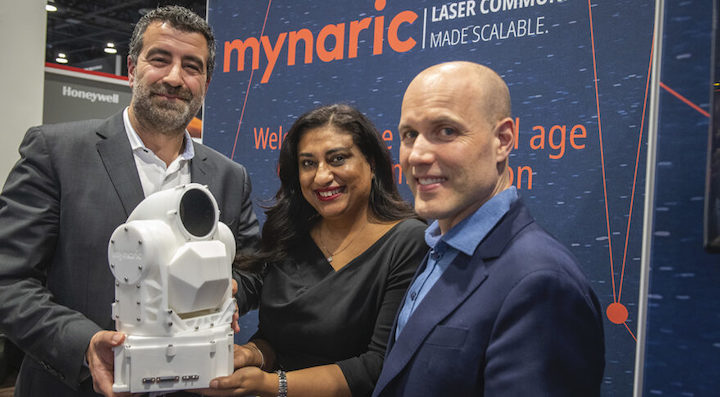28.08.2021

COLORADO SPRINGS — German antenna maker Mynaric unveiled a new optical satellite terminal Aug. 25 amid its push into the U.S laser communications market.
The CONDOR Mk3 antenna adds a smaller, lighter and low-power option to Mynaric’s portfolio, with configurable data rate speeds of between 100 megabits per second to 100 gigabits per second.
Mynaric anticipates Mk3 will comply with standards for the up to 150 operational satellites that the Pentagon’s Space Development Agency plans to order early next year.
SDA plans to issue a request for proposals for this fleet of low Earth orbit satellites, called Tranche 1, next week. It expects to issue contracts early 2022 for the constellation, comprising a Transport Layer of data-relay satellites and a Tracking Layer of sensor satellites to detect and track missiles.
Tranche 1 would follow the 28 demo satellites under Tranche 0 that Lockheed Martin and York Space Systems are building toward a launch in late 2022.
Meanwhile, Mynaric said it has already signed up a customer for Mk3. The undisclosed customer has secured options for 20 units from the fourth quarter of 2022.
“We are incredibly proud to have already secured a lead customer before even having officially launched our next generation CONDOR terminal, today,” Mynaric chief commercial officer Tina Ghataore said in a Aug. 25 statement.
“The Space Development Agency’s intent to use their Transport Layer satellites to receive data directly in space opens up completely new channels for commercial satellite operators.”
U.S. positioning
Mynaric is positioning its products for SDA amid wider expansion plans for the U.S. market.
The company is listed on the Frankfurt Stock Exchange but is also planning to trade shares in the U.S. this year, according to Ghataore.
“Our customers are here so it just makes sense,” Ghataore told SpaceNews on the sidelines of the Space Symposium in Colorado.
She declined to discuss the fundraising plans, citing German financial regulation.
It comes after Mynaric opened a sales and regulatory office earlier this year in Washington.
The company has another facility in Hawthorne, California, that is a mixture of office space and a laboratory that focuses on interoperability.
“One of the key things for SDA and others is, if laser com terminals become a commodity item — and you do want to have multiple players, it makes sense — you want to make sure they’re able to communicate with one another,” she said.
Mynaric has also decided to produce the modems that process its data and drive its optical heads in the United States instead of Germany.
“That’s a big shift from where we were six months ago,” Ghataore said.
This is partly because of demand it sees from other government agencies in the country, Ghataore added, and “the opportunities that exist beyond the people who are driving the adoption of optical terminals today.
“If they ever want to sell connectivity and data to some other U.S. government actors, they can be assured that they’re purchasing equipment that was assembled and integrated here.
“Another reason for us to do it is all of our parts were coming from the U.S., and we were shipping them to Germany” for assembly, integration and testing.
Quelle: SN

